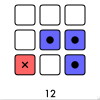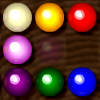
Description
ATM, a game to help with learning how to use a bank cash machine.
Instructions
After the loading screen you will be taken to Granny Olltwit’s hall by her front door where two envelopes will arrive through the letter box. Clicking on these letters opens them and explains all about the cash or debit card received and the PIN (Personal Identification Number) to go with it. You must memorise the PIN to be able to use the cash machine, just like in real life. The PIN changes with each use of the program and can be seen by clicking on the tear off slip on the second letter. Once you tear off the strip and memorise the number, a button will highlight allowing you to go outside Granny Olltwit’s house to find the cash machine.
Once in the street, you can move Granny Olltwit left or right along the pavement by clicking with your mouse. You will notice that the mouse horizontal movement is followed by a green direction arrow, which is what Granny Olltwit follows. Just to the left of Granny Olltwit’s front door is a bank with a cash machine. If you place your mouse pointer over the cash machine you will see a flashing indicator. Click here and Granny Olltwit will first be shown a Check List of the main functions of a cash machine. After you complete each of these tasks a green tick will appear next to each one. Click the Use Cash Machine button on this screen to move on to the cash machine, where a close up view of the machine will be shown.
In the close up of the cash machine, Granny Olltwit can insert her new card into the slot on the right hand side by placing it over the slot and left mouse clicking. Once the card is in the machine, she can perform the tasks of a standard cash machine including, withdrawing cash, see her balance, changing her PIN to a more memorable number etc. Firstly she must input her correct PIN as instructed by the machine. Follow the instructions on screen for all the available transactions to get used to how the real thing works. Each withdrawal will reduce the amount of money in her account so once the limit is reached, Granny Olltwit will be unable to withdraw any more, just like in real life. Also, if she gets the PIN wrong, the machine will retain her card if she keeps inputting the wrong number. When the card is returned, just click on it to take it back. Similarly when cash is given at the bottom of the machine, just click on it to take it and the same with printed receipts or balances requested.
When you complete all the five main tasks on your Check List a certificate scroll will appear. Clicking the button below it will take you to the certificate screen.

Description
An online maths game with an almost infinite supply of math subtraction problems to solve.
Instructions
On the opening screen you will find that your mouse pointer turns into a hand over the three types of problems you can choose. Choose a type of subtraction sum that you would like to try ranging from single to three figure problems.
The Questions
Once you have clicked on your choice, a random question will appear which you have to solve by clicking on the numbers in green in the white boxes at the bottom of the blackboard. Sums in the second and third level have a green box around the column of numbers that you should solve first. They also have a Borrow One button below the sum’s bottom line, which is explained below. You will be told visually and audibly whether you have got the answer correct or not. When you are able to try the next sum, the Next Sum button will become active at the bottom of the board. At anytime you can try a new level by clicking on the New Level button at the bottom.
Borrow One button
If the number at the top of a column is smaller than the one at the bottom, then it is not possible to take away one from the other. Therefore, in order to make the top number bigger you “Borrow One” from the top of the column to the left. This has the effect of adding 10 to the number at the top of the column you are working in. At the same time, you reduce the number at the top of the column to the left by one. When you click on the Borrow One button, you will see that the above is done automatically. Another method is instead of taking one from the top number of the column to the left, you can add or Pay Back one to the number at the bottom of that column to the left.

Description
An online maths game with an almost infinite supply of maths multiplication problems to solve.
Instructions
On the opening screen you will find that your mouse pointer turns into a hand over the three types of problems you can choose. Choose a type of multiplication sum that you would like to try ranging from single to three figure problems.
The Questions
Once you have clicked on your choice, a random question will appear which you have to solve by clicking on the numbers in green in the white boxes at the bottom of the blackboard. Sums in the second and third level have a green box around the numbers that you should solve first. On screen graphics will tell you what to do if you are not sure. You will be told visually and audibly whether you have got the answer correct or not. When you are able to try the next sum, the Next Sum button will become active at the bottom of the board. At anytime you can try a new level by clicking on the New Level button at the bottom but be aware that your score will drop to zero and any stars earned will be lost. The question number, scores and stars will be kept only if you move to the certificate screen and back to the same level.
Tables
To help with you there is a Tables chart at the top of the screen. It’s the yellow tab with CLICK TO LOWER TABLES on it. Click this and the chart showing the Times Tables from 1 to 9 will be shown. Click the chart again to raise it back to the top of the blackboard. Clicking this chart does not alter your score but does affect how many stars you are awarded (see below).
The Tables chart has the numbers 1-9 along the top and also down the left hand side. Take one of the two numbers you are multiplying together and find its row down the left hand side. Follow this row along until you are in line with the column which has your second number at the top. The place where the column and the row meet is the answer to the two numbers multiplied together. For example 5 X 4. Find the number 5 in the darker yellow column down the left hand side. Follow this row along to the right until you are under the number 4 in the darker yellow row at the top of the table. Where the row and the column overlap you will see the number 20.
Bonus Stars
One gold star is awarded in a level, each time you get 10 answers correct without using the Tables described above. Any stars earned in a level will be shown on your certificate. Please note any stars earned in one level, are lost if you try another level.

Description
An online maths game with an almost infinite supply of math division problems to solve.
Instructions
Choose from 3 levels of division sums ranging from single digits to three figure problems. Each sum is randomly produced one at a time on a blackboard style interface. Audio and visual encouragement tells you when you are right and when you need to try again.
The Questions
Once you have clicked on your choice, a random question will appear which you have to solve by clicking on the numbers in green in the white boxes at the bottom of the blackboard. You will be told visually and audibly whether you have got the answer correct or not. When you are able to try the next sum, the Next Sum button will become active at the bottom of the board. At anytime you can try a new level by clicking on the New Level button at the bottom but be aware that your score will drop to zero and any stars earned will be lost. The question number, scores and stars will be kept only if you move to the certificate screen and back to the same level.
Level 1
In Level 1 the answers to all the problems are whole numbers. The number in the white divide box is called the dividend and is the figure to be divided. The number to the left just outside the box is called the divisor. Basically you have to find out how many of the divisor number is in the dividend. For example if the dividend is 20 and the divisor is 5, the problem is to find out how many 5’s there are in 20. The best way to think of this is a cake cut into pieces. In this problem the cake has been cut into 20 pieces. You have 5 greedy boys to feed with the cake but so that each one gets the same you need to know how many slices each one can have. Remove 5 slices and put them on an imaginary plate. Remove another 5 and put them on another plate, and then another etc. You should find that you end up with 4 plates each with 5 slices of cake on them. This means that there are 4 lots of 5 in 20.
Level 2
Not all answers to division problems are exact. In Level 2 the answers to the problems are a mixture of whole numbers and ones with what is called a remainder. Using the cake example above, you have a cake which has been pre cut in the shop into 20 slices. This time you have 6 hungry boys to feed. Remove 6 slices and put them on an imaginary plate. Remove another 6 and put them on another plate, and then another etc. You should find that you can only fill 3 plates with 6 slices of cake on them and there will be 2 slices of cake left. This means that there are 3 lots of 6 in 20 with a remainder of 2. If this was the question in my program then firstly you would click the number 3 as being the first part of your answer. Then click the Remainder button to add a letter R after your answer. Then click the number 2 being the amount remaining. So your answer to 20 divided by 6 is 3 remainder 2 i.e. 3×6=18, 20-18=2.
Level 3
In Level 3 the dividend numbers get a little bigger and some may have two lots of remainders. For example 100 divided by 6. If this problem was on the screen you would see that as well as a green box around the divisor 6 there is another green box around part of the dividend. In this case the box encloses the number 10. The green boxes should be worked out first, so how many 6’s are there in 10? Well there is only 1, 6 in 10, so your first answer to click will be 1. But 10 is bigger than 6 so there is a remainder. 10-6=4 so click the Remainder button and the number 4. The number 4 should appear not at the end of the sum but just before the last 0 and a green box should appear around these two numbers. With 4 next to the 0 this number is now just as you would read it. It is no longer 0, it is now 40. So the problem is now how many 6’s are in the number 40. The answer is that there are 6, 6’s in 40 with 4 left over as a remainder. 6×6=36, 40-36=4. So the next number to click is 6 followed by the remainder button again and then click the number 4 being what is left over after the sum has been solved.
Remainders help you to understand how division works but in today’s World we work in decimals. In the last problem you could continue to work the problem out by placing a decimal point after your top answer i.e. 16. The remainder 4 would then go against an imaginary 0 to make 40 again. You then keep on dividing by 6. In this problem your answer would be never ending i.e. 16.6666666666666666666666 etc. which is why it is not practical for this program to show the decimal answer to the problems. If you did this problem on a calculator it would also probably give up and produce an answer of say 16.6666667. This is because many calculators are restricted to a set number of digits, so it rounds the last digit up one if the next number in the sequence is above 5. In more advanced mathematics the correct way to express this answer is to say 16.6 recurring i.e. the 6 goes on and on indefinitely.
Tables
To help with you there is a Tables chart at the top of the screen. It’s the yellow tab with CLICK TO LOWER TABLES on it. Click this and the chart showing the Times Tables from 1 to 9 will be shown. Click the chart again to raise it back to the top of the blackboard. Clicking this chart does not alter your score but does affect how many stars you are awarded (see below).
The Tables chart has the numbers 1-9 along the top and also down the left hand side. In Division take the first number to the left of the white divide box, this is called the divisor. Find this number’s row down the left hand side of the Tables. Follow this row along until you find a number which is the same or just above the second number in the question enclosed in the divide box. This second number is called the dividend. The number at the top of this column in the darker yellow is the answer if the number in the main Table is the same as the dividend. If the number in the Table is just below the dividend then the number at the top is still the first part of your answer but there is also a remainder. The remainder is the number left over after you subtract (take away) the dividend from the number in the main Table. For example 5)30 where 30 is the dividend (the number to be divided) and 5 is the divisor. Find 5 in the left hand column of the Tables and move along that row until you reach 30. Look up to the top of the column in which 30 appears and you will see the number 6, which is the answer to the problem i.e. there are 6, 5’s in 30. If instead the dividend was say 31, then 6 would still be the answer but there would also be a remainder. The remainder in this problem is 1 as the dividend 31, take away the answer to 5×6 which is 30, =1 (31-30=1).
Bonus Stars
One gold star is awarded in a level, each time you get 10 answers correct without using the Tables described above. Any stars earned in a level will be shown on your certificate. Please note any stars earned in one level, are lost if you try another level.

Description
The classic game of hangman which has been proven over many generations, to improve spelling and general knowledge in a fun easy to play format. Choose from eleven categories within the game including, animals, Bible characters, birds, capital cities, countries, sports, vegetables, insects, flowers and fruit.
Instructions
Over 500 words and phrases are included in the game plus you can create your own hangman word and phrases lists here online and play them right within the game by choosing the My Hangman option. Your own lists are saved and can be recalled, edited and re-saved at any time. Full instructions are provided on every screen and a high score table keeps track of best efforts.

Description
An online maths game with an almost infinite supply of math addition problems to solve.
Instructions
Once you have clicked on your choice, a random question will appear which you have to solve by clicking on the numbers in green, in the white boxes at the bottom of the blackboard. Sums in the second and third level have a green box around the column of numbers that you should solve first. They also have a carry one button below the sum’s bottom line, when you have an answer to that column which is greater than ten. You will be told visually and audibly whether you have got the answer correct or not. When you are able to try the next sum, the Next Sum button will become active at the bottom of the board. At any time you can try a new level by clicking on the New Level button at the bottom.






















